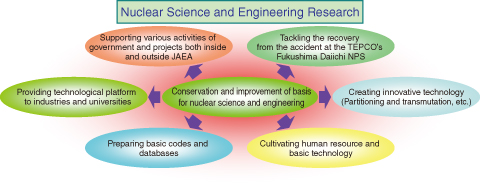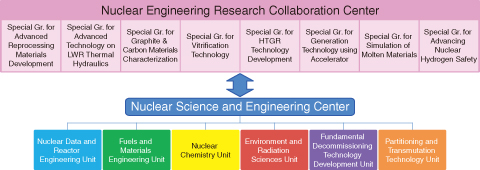
Fig.4-1 Roles of nuclear science and engineering research
We serve various roles to conserve and improve the foundation of nuclear science and engineering.

Fig.4-2 Nuclear Engineering Research Collaboration Center
To create innovative and practical products, joint research with industry and academia is being promoted.
Nuclear science and engineering research aims to promote activities, as shown in Fig.4-1, including recovering from the accident at the Tokyo Electric Power Company, Incorporated Fukushima Daiichi Nuclear Power Station (1F) and developing transmutation technologies to reduce the amount of long-lived radioactive waste. In the field of nuclear data and reactor engineering, we are working on the Japanese Evaluated Nuclear Data Library (JENDL), measuring nuclear data, and developing methods to design nuclear reactors using advanced theoretical, experimental, and simulation approaches (Topics 4-1, 4-2, and 4-3). In the fuels and materials engineering field, we are promoting research on nuclear fuels and materials used in reactors and on fuel-cycle facilities (Topics 4-4 and 4-5). In the nuclear chemistry field, we are promoting the analysis of basic data for reprocessing and detecting extremely small amounts of nuclear materials (Topics 4-6, 4-7, and 4-8). In the environmental and radiation science field, we are promoting studies on radionuclides in the environment and the development of a database for radiation protection (Topics 4-9 and 4-10). Joint research with industry and academia is also being promoted via the Nuclear Engineering Research Collaboration Center (Fig.4-2).
Developing the fundamental technology to decommission 1F involves enhancing our capabilities to characterize fuel debris, to analyze the durability of materials, to develop criticality management strategies, and to estimate radioisotope production (Chapter 1, Topics 1-1, 1-9, 1-10, 1-14, 1-16, and 1-19).
Using accelerator-driven subcritical systems (ADS), we are studying technologies to partition minor actinide (MA) nuclides (e.g., neptunium and americium) and fission products from spent nuclear fuel, and to perform MA transmutation.
Basic technology development is conducted at the JAEA research facilities. These technologies target radiation measurement (Topics 4-11 and 4-12) methods to assess durability of capsule materials in the reactor exposed to long-term irradiation (Topic 4-13) and safety management systems for the radiation-controlled area (Topic 4-14).